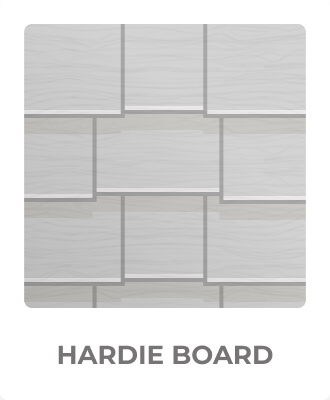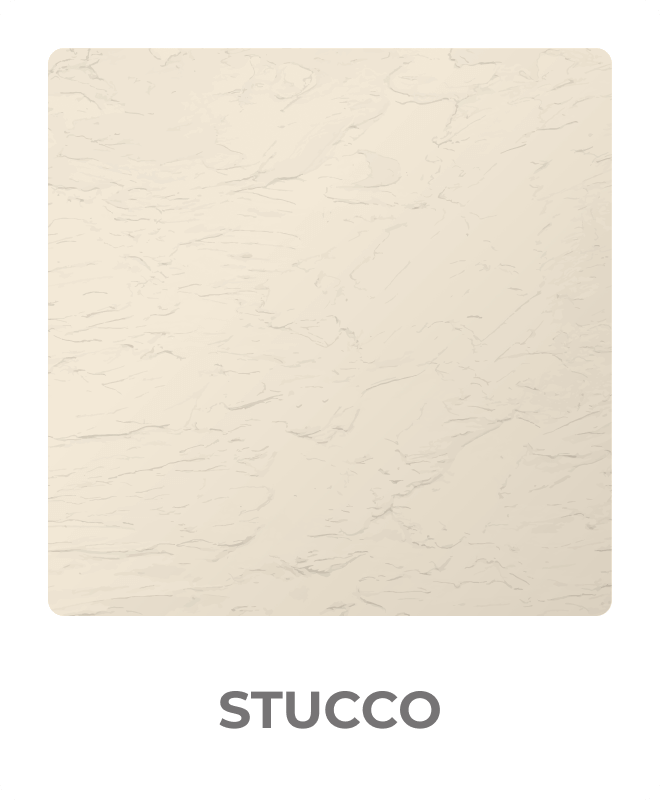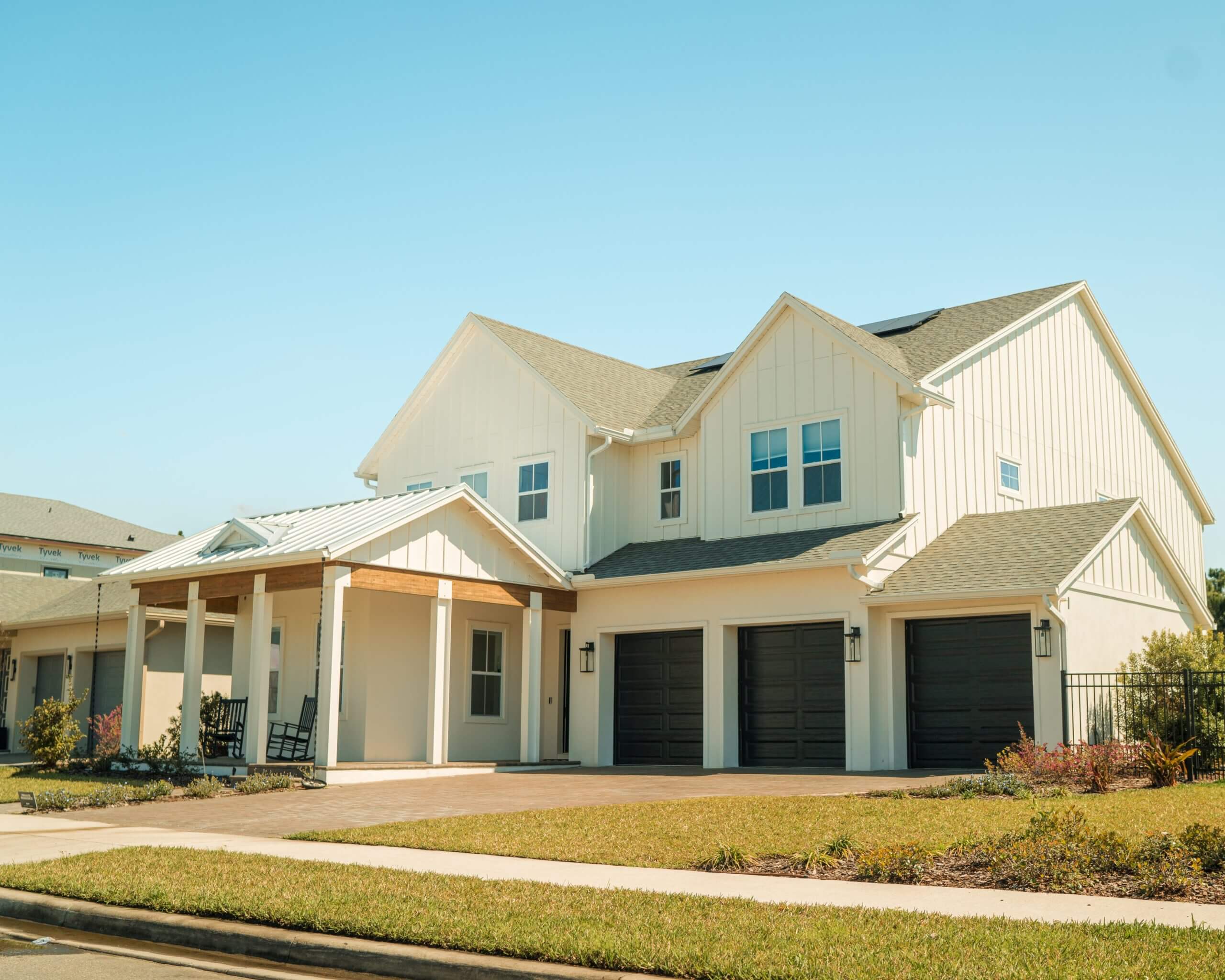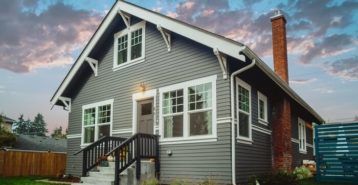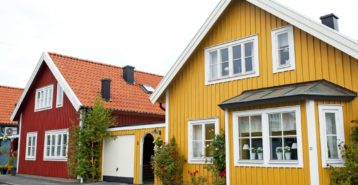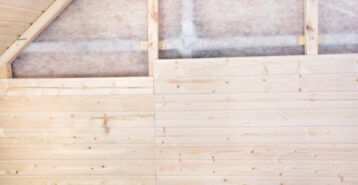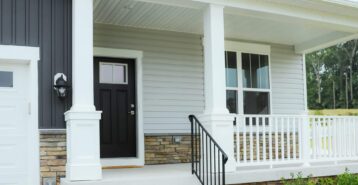Types of Siding for Homes
Siding comes in an array of materials that offer a variety of benefits and come at different price points. The national average cost to install siding on a 2,500-square-foot home is $27,133. The type of siding you choose, along with your home’s size, will affect your final project cost. Additionally, 2026 is a great time to replace your siding as there are now advances in vinyl and veneer siding. These types of siding for homes allow you to create the more expensive look of stone, brick, and cedar shake without the higher cost.
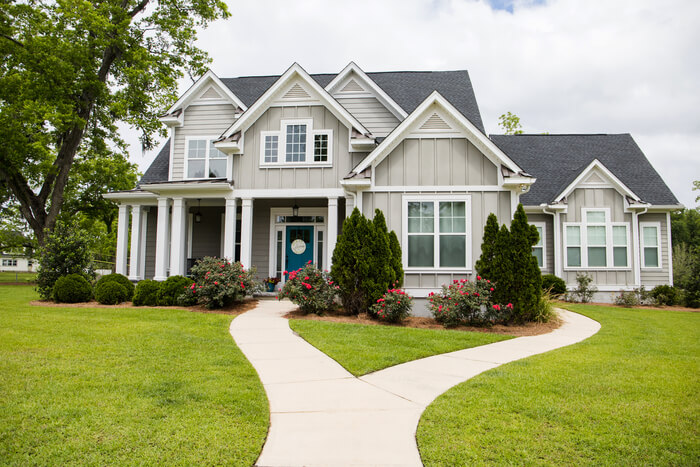
Top 12 Types of Siding for Homes
Vinyl Siding
More than 30% of American homes feature vinyl siding, making it the most widely used siding option in North America. Its popularity comes from affordability, durability, and low maintenance. Available in a wide range of colors and textures, vinyl siding can suit nearly any style. At $4 to $12 per square foot, it’s one of the most budget-friendly siding choices, especially for homeowners in colder climates or regions with frequent storms.
Best for: Homeowners who want a low-cost, versatile, and low-maintenance siding option.
Pros:
- Affordable compared to other siding types
- Resistant to weather, insects, and fading
- Dozens of color and style options
- Can last 20 to 40 years with minimal upkeep
Cons:
- Can crack in extreme temperatures
- Lower resale value compared to premium siding types
- May warp if not properly installed
Tips: Clean with a soft brush or garden hose once or twice a year to prevent dirt and mold buildup. Avoid high-pressure washing, which can damage panels.
Fiber Cement Siding
Fiber cement siding has grown rapidly in popularity for its durability, fire resistance, and affordability. It comes in various designs like lap, shake, or panels and can be made to look like wood, stone, or brick. Priced at $6 to $15 per square foot, it offers a strong balance between cost and performance, lasting over 50 years with proper care.
Best for: Homeowners who want long-lasting siding that performs well in extreme weather.
Pros:
- Extremely durable and fire-resistant
- Available in many colors and styles
- Resistant to pests, rot, and warping
- Can mimic the look of wood or stone
Cons:
- Higher upfront cost than vinyl
- Requires professional installation
- Can be heavy and labor-intensive to install
Tips: Repaint or refinish every 15 years to extend the warranty and preserve appearance.
Natural Wood Siding
Wood siding provides a classic and rustic charm that few other materials can replicate. Available in clapboard, lap siding, shakes, or shingles, it ranges from $7 to $14 per square foot. While beautiful and durable, natural wood requires more upkeep than other types of siding for homes, including treatments to prevent termites and weather damage.
Best for: Homeowners who value natural aesthetics and don’t mind ongoing maintenance.
Pros:
- Attractive, classic appearance
- Customizable with paints and stains
- Mid-range pricing compared to premium options
- Can last 20 to 40 years with maintenance
Cons:
- Requires frequent upkeep
- Vulnerable to pests, rot, and fire
- Higher long-term costs due to maintenance
Tips: In warmer climates, repaint or restain every 4 to 6 years, and apply fungicide or mildew deterrents every 3 to 4 years.
Cedar Siding
Cedar siding is considered a premium wood option, delivering durability and beauty in the form of shakes, shingles, or panels. Costs average $10 to $19 per square foot. More resistant to moisture than other woods, cedar is less likely to rot while offering a naturally rustic aesthetic.
Best for: Homeowners who love the look of wood but want better durability than standard wood siding.
Pros:
- Naturally resistant to moisture and decay
- Available in many textures and grains
- Eco-friendly and biodegradable
- Can last 20 to 40 years
Cons:
- Higher upfront cost than standard wood
- Requires painting or staining to maintain color
- Susceptible to insects if not treated
Tips: Choose tongue-and-groove panels for a modern look, or board-and-batten for a rustic style. Treat with stain or oil to preserve the finish.
Hardie Board Siding
Hardie board is a type of fiber cement siding created by James Hardie in the 1970s and remains one of the most recognized siding brands today. Made of 90% sand and cement, it’s known for its fire resistance, rot resistance, and ability to handle coastal conditions like salt spray. At $6 to $15 per square foot, Hardie board is more expensive than vinyl but longer-lasting, with a transferable 50-year warranty.
Best for: Homeowners who want a durable, eco-friendly siding that mimics other styles.
Pros:
- Very durable and weather-resistant
- Fire- and pest-resistant
- Comes in many colors and designs
- Lasts 50+ years with low maintenance
Cons:
- Higher upfront cost than vinyl
- Heavy, requires professional installation
Tips: Hardie board is sustainable, with 90% of materials sourced regionally. Repaint every 15 years to maintain warranty coverage.
Stucco Siding
Stucco siding is made from a mix of cement, sand, and lime, and is extremely durable, affordable, and energy-efficient. Common in Southwestern and Pacific homes, stucco covers about 50 to 60% of properties in those regions. At $7 to $17 per square foot, it’s cost-effective, energy-saving, and low-maintenance.
Best for: Homeowners in dry, warm climates who want affordable, energy-efficient siding.
Pros:
- Very affordable installation
- Great insulation and energy efficiency
- Fire-resistant and long-lasting
- Can be finished in a variety of textures
Cons:
- Not ideal for wet or damp climates
- May crack over time if not properly installed
Tips: If you live in a rainy or humid region, consider fiber cement instead, as stucco performs best in dry climates.
Aluminum Siding
Aluminum siding has been popular since the 1940s thanks to its affordability and durability. At $6 to $10 per square foot, it’s cost-effective while offering good weather, rust, and fire resistance. Aluminum is lightweight, eco-friendly, and can last 40 years or more, though it can dent or scratch more easily than other materials.
Best for: Homeowners looking for affordable, durable siding that resists moisture.
Pros:
- Affordable installation
- Resistant to fire, mildew, and rust
- Can be painted to refresh appearance
- Long lifespan of 40+ years
Cons:
- Dents and scratches easily
- Can look outdated compared to newer siding types
Tips: Repaint aluminum siding when it looks weathered, and replace dented panels promptly to maintain curb appeal.
Steel Siding
Steel siding is durable, fire-resistant, and able to withstand extreme temperatures. Because steel is heavier than aluminum, it’s more resistant to dents. It can also mimic the look of vinyl, wood, or board-and-batten siding. At $7 to $16 per square foot, steel siding is affordable compared to natural stone or brick while offering excellent longevity.
Best for: Homeowners in regions with harsh weather who want strong, low-maintenance siding.
Pros:
- Resistant to fire, pests, mildew, and mold
- Available in many colors and styles
- Lasts 40+ years with minimal upkeep
- More durable than aluminum
Cons:
- Heavier and trickier to install
- More expensive than aluminum
Tips: Choose factory-finished steel siding to avoid the need for repainting, and hire professional installers due to its weight.
Natural Stone Siding
Faux Stone Veneer Siding
Stone veneer siding mimics the look of natural stone at a much lower price, typically $10 to $30 per square foot. Made of lightweight panels, it reduces strain on your home’s structure while still being durable. While not as strong as natural stone, it can last 20 to 75 years with proper care.
Best for: Homeowners who want the stone look without the heavy cost or weight.
Pros:
- Mid-range pricing compared to stone
- Lightweight and easier to install
- Durable and weather-resistant
- Available in many styles
Cons:
- Less durable than real stone
- Made from concrete, which can break more easily
Tips: Use veneer siding for accent walls or partial siding to achieve a high-end look at a fraction of the cost.
Brick Siding
Brick siding is a timeless choice that offers excellent durability, weather resistance, and energy efficiency. Homes with brick siding benefit from natural insulation that helps lower utility bills. At $5 to $18 per square foot, brick is more affordable than stone while still lasting 100+ years.
Best for: Homeowners who want classic aesthetics with strong durability.
Pros:
- Extremely durable and long-lasting
- Naturally insulating and energy-efficient
- Resistant to fire, pests, and weather
- Requires very little upkeep
Cons:
- Higher upfront cost than vinyl or wood
- Mortar joints may need repairs after decades
Tips: Inspect mortar joints after 25 years, and repaint brick if you want to refresh or modernize the look.
Engineered Wood Siding
Engineered wood siding offers the natural look of wood with more affordability and durability. It’s manufactured in sheets or lap panels, making it easier to install than traditional wood. At $7 to $12 per square foot, engineered wood is budget-friendly while lasting 20 to 30 years with proper care.
Best for: Homeowners who want the wood look without the high cost or maintenance.
Pros:
- More affordable than natural wood
- Durable against pests, fungus, and mildew
- Available in many colors and textures
- Energy-efficient and eco-friendly
Cons:
- Can weather or decay at exposed edges
- Lacks natural wood grain variation
Tips: Repaint engineered wood every 5 to 10 years to extend its lifespan and preserve curb appeal.
How to Choose Between Siding Options
With so many siding types on the market, it can be tough to decide which one is best for your home. To simplify the process, focus on these six key factors: cost, durability, color options, weather resistance, maintenance needs, and aesthetics.
1. Cost
Budget is usually the first consideration. Each siding type comes with its own price per square foot, and your home’s total square footage will determine the overall cost.
- Vinyl is the most affordable at $4 to $12 per square foot.
- Natural stone is the most expensive, running $30 to $48 per square foot.
Use the Modernize Siding Cost Calculator to estimate your project total based on home size, location, and siding type. Remember that siding can also impact your resale value. Certain materials yield higher return on investment.
2. Durability and Lifespan
How long your siding lasts depends on the material, maintenance, and climate.
- Vinyl lasts 20 to 30 years.
- Fiber cement lasts 50+ years.
- Natural stone can last 100+ years.
Longer lifespans usually mean higher costs, so balance durability with budget.
3. Colors
Some siding types come in dozens of colors, while others have limited options.
- Vinyl, Fiber Cement, and Hardie Board: Wide range of colors.
- Brick, Stone, and Metal: Fewer color choices.
Many siding types can be painted, but not all colors look good on every material. Always confirm options with your contractor before committing.
4. Weather and Climate
Where you live plays a big role in which siding works best.
- Fiber Cement: Excellent for humid, wet, and hurricane-prone areas.
- Vinyl and Wood: Less weather-resistant; prone to damage in severe storms.
- Metal: Rust- or corrosion-resistant, making it good for some coastal regions.
| Types of Climates | Type of Siding |
|---|---|
| Best for wet climates | Fiber cement |
| Best for hot climates | Aluminum and steel |
| Best for dry climates | Stucco |
| Best for cold climates | Natural stone and brick |
| Best for hurricane-prone areas | Fiber cement |
| Best for coastal homes | Hardie board |
5. Maintenance Needs
Maintenance requirements vary widely.
- Low Maintenance: Vinyl (annual wash with soap and water).
- High Maintenance: Wood (needs staining or painting) and stone (needs inspection and cleaning).
Choose siding that fits your lifestyle and willingness to maintain it.
6. Aesthetics
Siding has a huge impact on curb appeal and resale value.
- Fiber cement can mimic wood, brick, or stone at a lower price point.
- Natural stone and brick offer timeless, high-end looks.
- Engineered wood gives you the warm look of wood with easier upkeep.
Think about how the siding complements your home’s style and neighborhood character.
How to Find a Trusted Siding Installer With Modernize
If you have a particular type of siding in mind for your upcoming project, we recommend comparing its return on investment to other types of siding before starting the installation. Then, you will be ready to get in touch with professional contractors in your area and compare quotes for the job. Use our Contractor Checklist to hire the most qualified professional to handle the siding installation. Next, tap into the Modernize network of reputable siding installers to find the best one suited for your home and needs.
